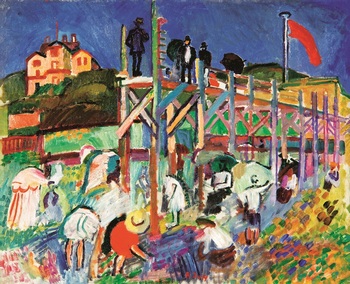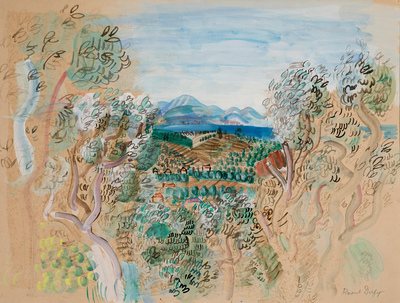Raoul Dufy: reinterpreting isms
Impressionistic? Cubist? fauvist? There are many labels with which Raoul Dufy’s work has been defined and delimited. But the truth is that the painter of Norman origin traveled through these isms without ever leaving his own trail.
In the Paris of Picasso Cocteau or Apolliner and the million isms that swarmed at that time in the world capital of art, Dufy represents a great vortex born in the School of Paris capable of assimilate and adapt the precepts and interests of impressionism, cubism and fauvism based on their own, recording in each and every one of its creative stages the hedonistic character , which as an identity seal earned it the qualification of “born under the sign of pleasure.” However, although the apparent frivolity and superficiality of his aesthetics is true, his work is the result of the continuous experimentation to which he submits it in a constant search for new plastic solutions that slowly developed a completely personal language, more complex than naked eye we guess.

After beginnings marked by the influence of the Impressionist landscape painters and their vital need to find a way to capture the impressions that the human eye experiences before the landscape on the canvas, Dufy soon understood that the Impressionist language was not enough to meet certain aspirations that went far beyond mere visual satisfaction. In this regard, the discovery of the Fauvist painters, and especially the work of Pierre Matisse in the controversial Salon des Independants of 1905, marks a new direction, the impact of which will be the origin of his immediate affiliation with the Fauve group . It was before the chromatic explosion of “Luxury, calm and voluptuousness” that Dufy understood that art, far from mimeticly representing the reality of what we observe, should express the particular reality that is born from the vision and perception of the artist. Despite the brevity of his connection to the group, the fauves echoes will survive throughout his artistic evolution, determining his fondness for the use of a bright and arbitrary chromaticism that will now become the plastic translation of the artist’s emotions. In fact, and after a stage dominated by the influence of Cézanne where the progressive geometrization of forms brought him closer to Cubism, Dufy reached his mature style. Leaving behind the experimentations of the cubist method, the artist will intoxicate us with a powerful alliance between light, color and drawing with which he builds a true exaltation of the landscape, nature and ultimately of life.
In this sense, a large part of Dufy’s work and the most relevant in the set of different creative stages is dedicated to the theme of landscape. The continuous trips he made around Europe and especially to Provence and Italy, inspired a representation that, apart from realism, seeks his own internal, sensual and luminous reality . This is the case of the works made in 1922 during his trip to Sicily where, guided by the light of the Mediterranean and the strength it gave to the colours, he produced sumptuous watercolors such as this Sicilian view. Precisely the watercolor technique allowed him a greater degree of improvisation thanks to the speed with which he could make transitions between colors. Likewise, and taking advantage of the resources of the zenithal vision that he adapted from cubism, he develops great perspectives that, as here, suggest a sensation of spatial depth as if he were looking from an ideal point of view, which offers us the vastness of the world that surrounds him. Color and drawing appear dissociated through small, fast, sinuous and rhythmic brushstrokes that increase the dynamism and expressiveness of a landscape that expands with infinite vitality.
In short, Dufy displays endless technical and stylistic resources that show us that far from old clichés and the apparent simplicity and ingenuity of his work, the artist achieved a level of virtuosity and mastery within the reach of only the great masters of the avant-garde. .






